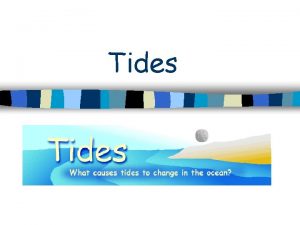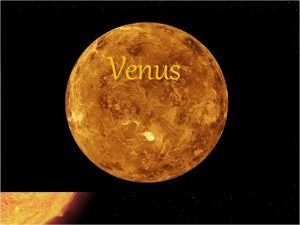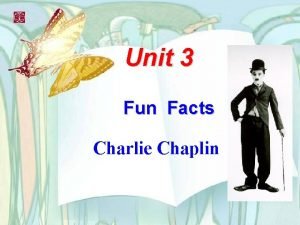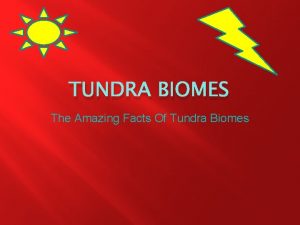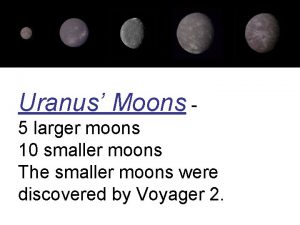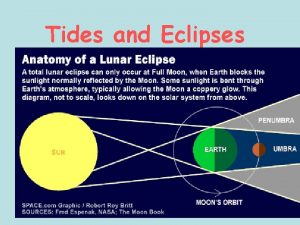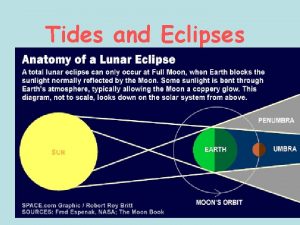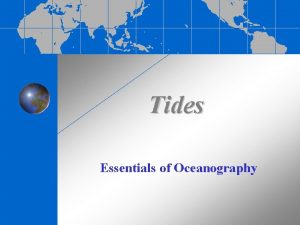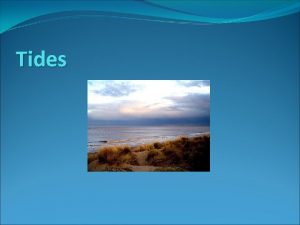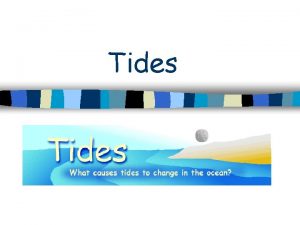Moons phases tides and other interesting facts All















- Slides: 15

Moon’s phases, tides and other interesting facts… All About the Moon

Moon’s Effect on Earth �Tides �Eclipses

Motions of the Moon-phases �Moons rises 1 hour later every night �Moon moves eastward among the stars �Moon takes 27. 3 days to complete one cycle around the earth (revolution) �Moon takes 29. 5 days to return to its original phase when cycle started (because we are moving also) �Moon’s apparent diameter changes in a cyclic manner and is about the same apparent size as the sun

Phases of moon-one cycle � New moon � Waxing Crescent moon � Waxing Quarter moon � Waxing Gibbous moon � Full moon � Waning Gibbous moon � Waning Quarter moon � Waning Crescent moon � New moon


Why do we see phases of the moon? �We always see the same side of the moon as it orbits the earth because the moon is orbiting the earth at the same rate that it is rotating. �https: //youtu. be/6 j. Up. X 7 J 7 y. So �As it orbits us, we see the portion illuminated by the sun �http: //www. history. com/shows/theuniverse/videos/phases-of-the-moon

Tides � Caused by the gravitational pull of the moon and the sun on earth � High tide: when the earth is facing the moon � Low tide: occurs on the side of the earth not facing the moon � Spring tide: highest high tide, lowest low tide � Neap tide: lower high tide, higher low tide

The change in tides is cyclic (every 6 hours from high tide to low tide � http: //oceanservice. no aa. gov/education/kits/t ides/media/supp_tide 0 6 a. html

Eclipses � Solar Eclipse: moon blocks out the sun (sme) � Occurs in the new moon phase � Earth’s shadow falls on the moon (sem) � Occurs in the full moon phase

Solar eclipse Path of Totality: path on earth where the total solar eclipse is visible

http: //www. classzone. com/books/earth _science/terc/content/visualizations/es 2505 page 01. cfm

Lunar Eclipse Usually red due to earth’s atmospheric aerosols

http: //www. classzone. com/books/earth _science/terc/content/visualizations/es 2504 page 01. cfm? chapter_no=2 5

And… �The change in size of the moon is due to its change in distance from the earth (apogee/perigee) �The change in shape of the moon is due to the phase observed of the moon �We see the phases because the moon if orbiting around the earth �The moon is illuminated by the sun

Fun Facts about the moon �Blue Moon: a blue moon is the 2 nd full moon that occurs in a month �Full moons have names- from Native American Indians- Worm Moon, Strawberry Moon etc. . �Galilieo refered to the moon a Cynthia in his anagram message to Julian de Medici when he was under house arrest-”Cynthiae figuras aemulatur Mater Amorum”-”The Phases of Cynthia are imitated by the Mother of Love”
 Interesting more interesting the most interesting
Interesting more interesting the most interesting Smkvqmuzwv4 -site:youtube.com
Smkvqmuzwv4 -site:youtube.com The difference between spring tides and neap tides
The difference between spring tides and neap tides Interesting facts about all saints day
Interesting facts about all saints day Http://nineplanets.org/
Http://nineplanets.org/ Vasco núñez de balboa interesting facts
Vasco núñez de balboa interesting facts Vampire squid facts
Vampire squid facts Charlie chaplin interesting facts
Charlie chaplin interesting facts Turkish culture facts
Turkish culture facts Facts about the tundra
Facts about the tundra Interesting facts about respiratory system
Interesting facts about respiratory system Interesting facts anne frank
Interesting facts anne frank What is the resolution of the most dangerous game
What is the resolution of the most dangerous game Richard connell
Richard connell Interesting facts about the great barrier reef
Interesting facts about the great barrier reef Interesting facts about mission santa clara de asis
Interesting facts about mission santa clara de asis


